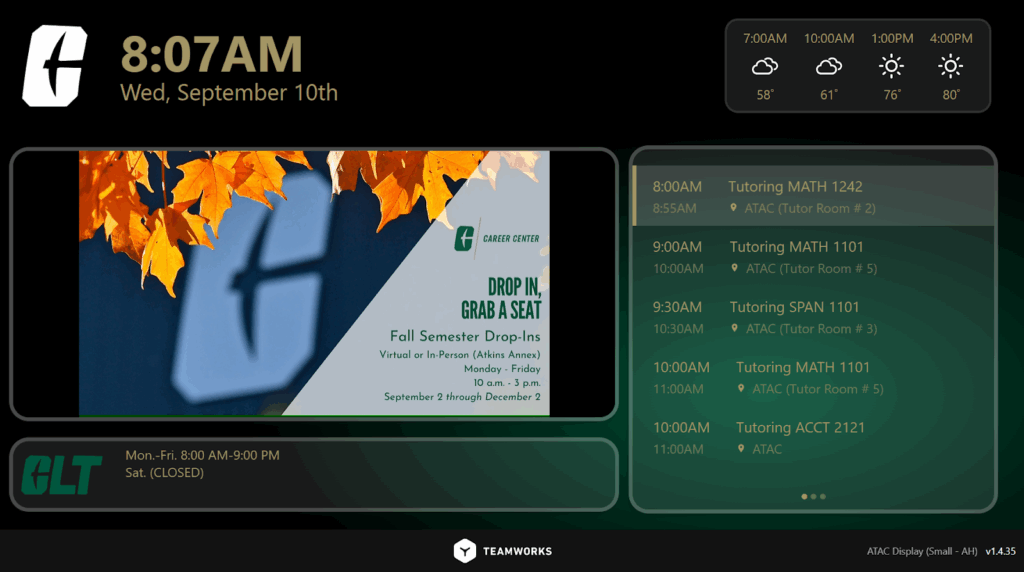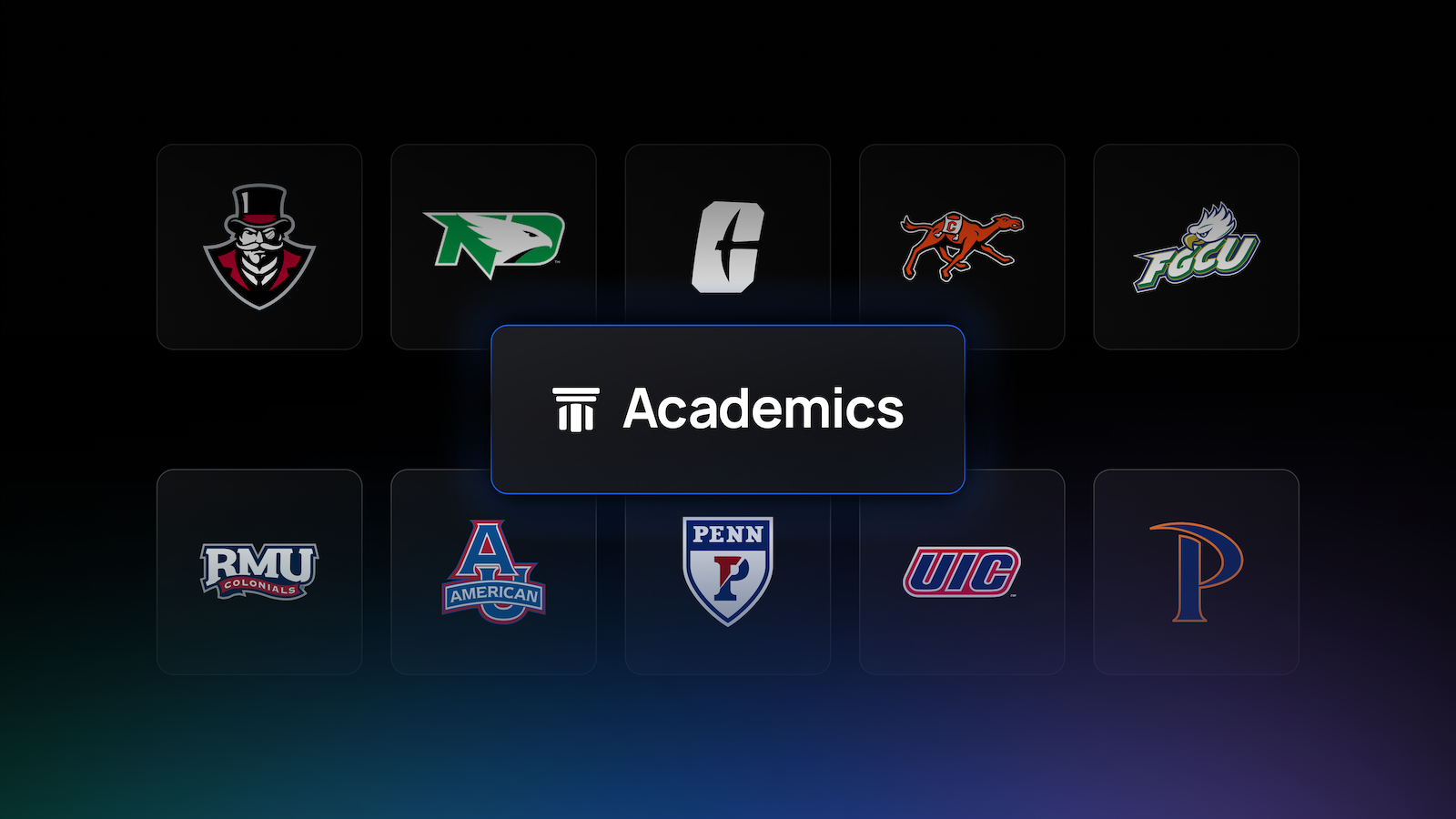It’s 11 pm on a Wednesday. You’re manually updating travel letters for the third time this week because the schedule changed again. Your inbox has 47 unread emails, half are from faculty requesting confirmation of student-athlete absences to coordinate accommodations, the other half are from student-athletes who missed study hall because they didn’t know how to sign out or which location was open. Tomorrow you have back-to-back meetings with at-risk students, but you haven’t had time to pull their progress reports. You’re doing the work of three people, and it shows in the GPAs.
Every athletics department knows this breaking point: hundreds of student-athletes, constant travel, eligibility pressure; managed by skeleton crews already stretched beyond capacity. The ten universities below didn’t add headcount. They didn’t lower standards. They changed the system they work in.
What This Means For Leaders
No one bought Teamworks Academics just to save a few clicks. They bought the outcomes:
- Hours → minutes, every week
- Better faculty relationships and fewer grievances
- More meaningful engagement and higher GPAs
- Scalable coverage without new headcount
- Credible reporting that supports decisions
The Transformation at a Glance:
⏱ Time Saved: Hours of administrative burden turn into high-impact minutes.
- Before: Travel letters consumed 2–3 hours each week, and advisors spent Fridays compiling spreadsheets.
- After Implementing Teamworks Academics: Travel letters take just 10 minutes, and reports are generated in two clicks—freeing advisors to focus on students instead of admin work.
🎓 Student Accountability & Academic Lift: More meaningful touchpoints, higher GPAs, fewer no-shows.
- Before: Students constantly asked, “How many hours do I have left?” and engagement was reactive.
- After Implementing Teamworks Academics: Real-time transparency keeps students informed and accountable, creating proactive academic conversations that drive measurable improvement.
🤝 Faculty Collaboration: Earlier, more clear data-driven communication.
- Before: Faculty frustrations over missed classes were common.
- After Implementing Teamworks Academics: Shared visibility fosters proactive communication that prevents conflicts before they happen.
📊 Data-Driven Accountability: Insights that influence coaches, deans, provosts, and presidents.
- Before: Conversations about attendance were anecdotal—“they miss a lot of class.”
- After Implementing Teamworks Academics: Clear, centralized data supports informed discussions with deans and provosts.
🚀 Operational Scalability: Small teams act like bigger ones.
- Before: Manual processes limited how much staff could accomplish.
- After Implementing Teamworks Academics: Automation and streamlined workflows amplify impact, allowing lean academic teams to scale their reach and effectiveness.
1) Time Liberation: Getting Hours Back Every Week
Pepperdine University — Travel letters moved from a manual slog to a fast, controlled workflow.
- Result 1: Administrative time on travel letters cut ~50–60%.
- Result 2: Professors receive one clean email per course listing all traveling student-athletes (no inbox spam).
Hear from Erin Carroll at Pepperdine University about how she cut time in half
Robert Morris University — Game-week chaos without the chaos.
- Result 1: Weekly football travel updates dropped from 2–3 hours to ~10 minutes.
- Result 2: During a March Madness run, academics ran on track; staff described Teamworks as “another staff member.”
Hear from Danny Bonaventura at Robert Morris University
Austin Peay University — Season-level efficiency.
- Result 1: A season’s softball travel letters in ~15 minutes.
- Result 2: Time saved converts directly into more student-facing work.
Hear from Bobby Fieman at Austin Peay
Campbell University— Admin friction removed.
- Result 1: Appointments went from consuming hours to “a few minutes of my week.”
- Result 2: Virtual kiosks make multi-location study halls simple and auditable.
Hear from Jared Fries at Campbell University
UNC Charlotte — Digitizing tutoring ops.
- Result 1: Digital Displays, a feature in Teamworks Hub, replaces daily printouts; rooms and sessions self-organize on screen.
- Result 2: Reminders reduce staff triage work and student confusion.
Hear more from UNC Charlotte about how they leverage Teamworks Academics

2) Reduction of Administrative Burden
North Dakota University — Structure → performance.
- Result 1: Advisor can meet with more students because meetings are more meaningful and structured.
- Result 2: An offensive lineman’s GPA improved +0.8 in one term using Tasks and coach visibility — the confidence ripple helped teammates adopt the same habits.
Hear from John Krill at the University of North Dakota
Campbell University — Behavior changes at scale.
- Result 1: Near-zero missed appointments in week one — because the calendar, reminders, and expectations live in one place.
- Result 2: GPAs up two straight years; team can point to attendance data and reduced misses.
Hear from Jared Fries from Campbell University
Austin Peay University — Less stress, better outcomes.
- Result 1: Student-athletes manage work and recovery better with a single schedule (class, lift, wellness, study hall).
- Result 2: Transfer-heavy rosters stabilize faster; many already know Tasks from previous schools.
American University — Right-sized habits for first-years.
- Result 1: A freshman who “loves checking items off” uses a two-week planning cadence in Tasks — realistic and sticky.
- Result 2: Accountability aligns across advisors, coaches, and students via shared records.
University of Illinois, Chicago — Real-time transparency drives behavior.
- Result 1: Students see study hall hours live on their phones; fewer “how many hours left?” interrupts.
- Result 2: Record departmental GPA follows better habits and fewer blind spots.
3) Faculty Trust & Fewer Grievances
Pepperdine University — Professors get clarity, not spam.
- Result 1: One email per course with every affected student; faculty explicitly praised the format.
- Result 2: Last-minute tennis event changes become minutes of work, not an afternoon.
American University — Turn tension into collaboration.
- Result 1: With Travel Insights, AU can tell a student, “You’ll miss this class seven times — let’s change sections now.”
- Result 2: In a live meeting with a concerned professor, they reconciled “six absences” to what would actually happen — grievance avoided.
Robert Morris University — Faculty engagement continues after the form.
- Result 1: Progress Reports trigger reply threads where professors give specific guidance (“seek tutoring,” “attend office hours”).
- Result 2: Nursing program adjustments for post-season travel were negotiated in time — clinicals saved, season supported.
University of Chicago, Illinois — Travel becomes a campus-credible dataset.
- Result 1: Initial “overall letter” by census + individualized event notices = no surprises.
- Result 2: Miss-class insights counter “they miss a lot” anecdotes with real numbers.
4) Operational Scalability (Small Staffs, Big Coverage)
University of Pennsylvania — 33 sports, ~950 varsity SAs, ~7 academic administrators (each wearing other hats).
- Result 1: Central scheduling + shared notes mean any advisor can pick up a case instantly — no dead ends when people are out.
- Result 2: In urgent eligibility cases, Hub group threads coordinate across departments; the student sees the plan and executes fast.
UNC Charlotte — Tutoring at two sites, no chaos.
- Result 1: Displays route students to the right room; study-only students see open rooms at a glance.
- Result 2: Compliance collaboration via CNR workflows eliminates back-and-forth emails.
Florida Gulf Coast University — Coaches self-serve, staff stop chasing.
- Result 1: Coaches check study hall progress in real time instead of popping in or pinging staff.
- Result 2: Fewer interruptions = more student meetings.
Campbell University — Reporting without the Friday spreadsheet.
- Result 1: Missed-meeting reports are two clicks, not manual compilation.
- Result 2: Advisors spend Fridays with students, not Excel.
5) Data-driven stories
When your operations run cleanly and your outcomes improve, you earn institutional credibility. This is where Teamworks Academics shifts from “nice to have” to strategic asset—because you can now tell a data-driven story that wins resources, protects budgets, and elevates athletics’ reputation on campus.
American University — Institutional storytelling with proof.
Result: Tutoring volumes and meeting-type trends roll from the Dean to the Provost to the President—not to boast, but to justify resourcing. When budget conversations happen, AU’s academic support staff can show exactly what they deliver and why it matters. The difference between “we work really hard” and “here are 2,847 touchpoints across 450 student-athletes with a 3.2 average GPA” is the difference between defending your existence and amplifying your impact.
University of Pennsylvania — Annual reporting and benchmarking that matter.
Result: Insights make it easy to show traffic, touchpoints, and outcomes—and to defend goals, not just activities. Penn doesn’t just survive Ivy League academic rigor; they demonstrate it with data that academic campus partners respect.
Austin Peay University — Practice blocks that respect academics.
Result: Travel/class conflict data informs practice windows and facility sharing; decisions improve because the numbers are on the table. Coaches adjust. Administrators buy in. Everyone operates from the same truth.
Robert Morris University — KPI trifecta.
Result: APR 990 (highest ever) alongside streamlined travel logistics during March Madness and automated study hall reporting. The story goes to campus leaders fully formed: “We hit record academic performance while expanding athletic success—and our small staff didn’t break.” That’s executive-level credibility.
The Cost of Waiting
Every week spent on travel letters is time lost with at-risk student-athletes.
Every missed touchpoint risks a GPA drop—and a retention hit.
Every spreadsheet hour is time your advisors aren’t advising.
The best programs didn’t add staff—they changed the system.
They lead with data, act faster, and win more.If you’re still juggling emails and spreadsheets, the cost is clear—GPA, APR, staff, and reputation.
Modernize now—or catch up later.
